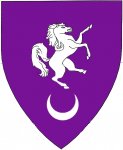RichGreen
Adventurer
The Fat Grouper
The Fat Grouper is likely to be the home base (or touchstone as Monte Cook calls it) for the campaign, at least initially, so I thought I'd better write some stuff about it!
The ‘Grouper is the centre of Flotsam, physically but also almost spiritually, for it’s here that many of the boat-town’s residents (particularly its fishermen) come to sink a few jars at the end of a tough day’s work. The tavern was formerly a caravel; the bar is situated below decks, although on sunny days, the cooking is taken outside and excellent grilled fish is served from a barbeque on the sterncastle.
The landlord of the ‘Grouper is Glyn Merryfield, a miserable and greedy halfling who constantly complains about how life has dealt him a bad hand. Glyn is fat, balding and pale from spending most of his time indoors. As well as the tavern, he also owns several decrepit houseboats nearby which he rents out for 10 sp per week. Glyn’s wife, Sarla, is younger and much more attractive but she's also a nagging shrew who bemoans the fact that they live in Flotsam on a boat. She will tell anyone who will listen to her shrill complaints that Glyn will never amount to anything unless he earns enough money to move their tavern to the Makers Ward. Even the Poor Ward would be an improvement!
Because this is Flotsam, the taproom isn’t fancy. The furniture is basic and built from rough wood, making splinters in the backside an occupational hazard of drinking here. The only décor is a stuffed five-foot long purple grouper hanging over the bar and a few other fisherman’s trophies: a shark’s jaw, a narwhal horn and a couple of fishing spears. The beer is a watered-down but cheap pale ale called Marlin Brew. The only other drinks on offer are rotgut (a nasty potato-based spirit) and a vinegary red wine known as Sahasran Ruby. Apple-flavoured sheeshah is also available and is popular with the regulars but it’s the food on offer which is the tavern’s saving grace. Sarla is actually a great cook so the food, almost always locally-caught fish (grilled or served as fish stew, chowder or curry) is very good indeed.
Secret: Sarla’s disappointment in Glyn has driven him to try and improve their situation by gambling at Fahil’s Floating Palace, a gambling “hall” (actually a large ship moored off a pier in the Poor Ward’s red-light district). Predictably enough, Glyn has been losing heavily at dice and now owes a small fortune to the house and its owner Zeno Meverel. If he doesn’t pay back what he owes soon, Meverel will call in the loans and Glyn will lose anything. His increasingly desperate situation means he is on the lookout for any kind of “get rich quick” scheme, however ludicrous, that might come his way.
Any comments? I'd love to have some suggestions for "get rich quick" schemes!
Cheers
Richard
The Fat Grouper is likely to be the home base (or touchstone as Monte Cook calls it) for the campaign, at least initially, so I thought I'd better write some stuff about it!
The ‘Grouper is the centre of Flotsam, physically but also almost spiritually, for it’s here that many of the boat-town’s residents (particularly its fishermen) come to sink a few jars at the end of a tough day’s work. The tavern was formerly a caravel; the bar is situated below decks, although on sunny days, the cooking is taken outside and excellent grilled fish is served from a barbeque on the sterncastle.
The landlord of the ‘Grouper is Glyn Merryfield, a miserable and greedy halfling who constantly complains about how life has dealt him a bad hand. Glyn is fat, balding and pale from spending most of his time indoors. As well as the tavern, he also owns several decrepit houseboats nearby which he rents out for 10 sp per week. Glyn’s wife, Sarla, is younger and much more attractive but she's also a nagging shrew who bemoans the fact that they live in Flotsam on a boat. She will tell anyone who will listen to her shrill complaints that Glyn will never amount to anything unless he earns enough money to move their tavern to the Makers Ward. Even the Poor Ward would be an improvement!
Because this is Flotsam, the taproom isn’t fancy. The furniture is basic and built from rough wood, making splinters in the backside an occupational hazard of drinking here. The only décor is a stuffed five-foot long purple grouper hanging over the bar and a few other fisherman’s trophies: a shark’s jaw, a narwhal horn and a couple of fishing spears. The beer is a watered-down but cheap pale ale called Marlin Brew. The only other drinks on offer are rotgut (a nasty potato-based spirit) and a vinegary red wine known as Sahasran Ruby. Apple-flavoured sheeshah is also available and is popular with the regulars but it’s the food on offer which is the tavern’s saving grace. Sarla is actually a great cook so the food, almost always locally-caught fish (grilled or served as fish stew, chowder or curry) is very good indeed.
Secret: Sarla’s disappointment in Glyn has driven him to try and improve their situation by gambling at Fahil’s Floating Palace, a gambling “hall” (actually a large ship moored off a pier in the Poor Ward’s red-light district). Predictably enough, Glyn has been losing heavily at dice and now owes a small fortune to the house and its owner Zeno Meverel. If he doesn’t pay back what he owes soon, Meverel will call in the loans and Glyn will lose anything. His increasingly desperate situation means he is on the lookout for any kind of “get rich quick” scheme, however ludicrous, that might come his way.
Any comments? I'd love to have some suggestions for "get rich quick" schemes!
Cheers
Richard
Last edited:



